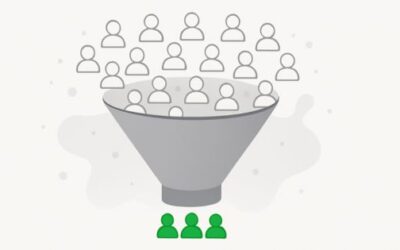Now more than ever, with tight spending layoffs, and increasingly difficult sales processes, it’s vital for businesses to have a deep understanding of their target audience. Developing an Ideal Customer Profile is step 1 in this journey.
What is an ideal customer profile?
An ideal customer profile is a detailed description of the type of customer that is the best fit for your products and services. An ICP differs from a buyer persona in that rather than individual traits, it instead focuses on the type of customer that is the best fit for your products or services. Particularly relevant in B2B or Account-Based Marketing campaigns, an ICP provides a high-level view, aiming to identify organizations that are a great fit for your offerings.
Some elements to include in your Ideal Customer Profile:
Industry
Identify the industries, verticals, or niches where your best customers operate in
Company Size
Consider not just the overall company size in terms of employee head count, revenue, or funding stage but also specific team sizes that you target. For example, a sales training company might look for businesses with over 100 employees AND a sales team of at least 10.
Location
Determine if there are specific geographic regions, countries, or even cities where your ideal customers are located.
Job Title/Role
Identify the key decision-makers, influencers, and end users within the organizations you target. Is it the VP of Sales or the Head of Product Development who is more likely to engage with your solution?
Tech Stack
This is particularly crucial for SaaS organizations. Understand which tools, software, and systems you customers use. Are you offering a new solution or are you replacing an existing vendor?
Problems
Pinpoint the main challenges, issues, or inefficiencies that your solution can address, whether or not your prospective customers are aware of these problems.
Defining these criteria clearly helps you focus on customers with the highest potential to convert and maintain loyalty over time.
Why do you need an Ideal Customer Profile?
Creating an ideal customer profile requires significant effort to research and define your ideal customer. However, the investment will pay off, especially in competitive or down turning markets. A well-defined ICP enables:
Targeted Marketing and Messaging
With a solid ICP, your marketing campaigns and sales messaging can directly address the identified needs of your ideal customers. By clearly understanding their problems, your communications become highly relevant, driving better engagement and higher conversion rates.
Customer Understanding
Developing an ICP compels you to dive deep into your existing customer base, examining their goals, challenges, and behaviors. This analysis helps refine your offering and anticipate future needs.
Customer Acquisition
Concentrating your sales and marketing strategies on the best-fit prospects can significantly lower your Customer Acquisition Costs (CAC). You avoid wasting time on poorly matched prospects, enhancing efficiency, and increasing the likelihood of the right customers, even with resources are tight.
Customer Experience
Understanding your ideal customers allows you to tailor every aspect of you business – from your website and messaging to customer support and sales tactics – providing an exceptional, customized experience.
Customer Relationships
A deep understanding of you customers’ business and consistently delivering value fosters long-term customer relationships. Your team members become seen as trusted advisors or consultants, strengthening customer loyalty.
How to develop an Ideal Customer Profile
Creating a comprehensive ideal customer profile is an intensive process that requires thorough research, detailed analysis, and contributions from various departments. Here are the crucial steps:
Conduct Market Research
Utilize industry reports, analyst insights, and other external data sources to understand the market landscape and pinpoint potential segments that align with your product.
Gather Data from Existing Customers
Compile feedback from your current clientele. Send out surveys, conduct interviews, analyze sales calls and support tickets to uncover recurring patterns and characteristics.
Analyze Existing Customers
With the collected data, refine your ICP by examining information in your CRM to understand the industry, size, and location of existing customers, along with their behavioral tendencies.
Define Key Criteria
Identify commonalities among your customers to establish crucial firmographic (company size and industry) and psychographic criteria (tech stack, challenges, and objectives) that encapsulate your ICP.
Build Lead Scoring
Construct a framework that evaluates each prospect based on the defined ICP criteria, prioritizing the leads that score the highest.
Validate your ICP
Engage with stakeholders from sales, marketing, customer success, and product development to ensure the ICP is aligned to sales strategy and overall business goals.
The more precise and detailed your ICP is, the more you can enhance close rate, lower customer acquisition costs, and increase the lifetime value of your customers.
Using your Ideal Customer Profile
Once you’ve developed your Ideal Customer Profile, the next step is to integrate it across your business operations. It should be the first and last stop for your go-to market strategies.
Align Marketing and Sales
Ensure that both you sales and marketing teams are fully briefed on the ICP. It’s crucial that they refine their targeting, tailor their messaging, and focus on the prospects that align most closely with the ICP criteria. Campaigns and content should resonate with the immediate needs and interests of your ideal customers.
Targeted Content
Consider the current challenges your facing is dealing with. Develop content and nurture campaigns that directly address these issues, providing value, and demonstrating your understanding of their situation.
Website Optimization
Review your website’s content and product messaging through the lens of your ICP. Determine which resources, messages, and user experiences will be most valuable to them and adjust your website accordingly.
Refine the Sales Process
Leverage insights from your ICP and Problem Identification Chart (PIC) to craft questions that can pinpoint ideal customers early in the sales cycle. Equip your teams with the knowledge to become experts identifying and solving the problems your ICP faces, ensuring they engage proactively and effectively.
Updates and Refinement
Crafting a functional Ideal Customer Profile is an investment in time, effort, and resources, but it’s important to treat it as a living document. Market fluctuations will require periodic adjustments in your ICP to stay current.
Following the implementation of strategies aligned with your ICP, it’s essential to evaluate performance indicators such as lead quality, sales cycle length, CAC, and conversion rates. This continuous monitoring ensures that your strategies are effectively tailored to your ICP and the right tactics are in place.
A well-defined ICP is one of the most powerful tools for any organization. It ensures your sales, marketing, and product efforts are reaching the right people and are laser-focused on solving the problems of your customers. Without an ICP you’re likely wasting resources on the wrong prospects and struggling to reach goals.






Does ICP restrict innovation? Focusing on a narrow ideal customer profile might help you optimize sales in the short term, but could it stifle innovation by overlooking new market opportunities?
What about the emotional side of ICP?
The focus here is on firmographics and challenges, but shouldn’t understanding the emotional needs and desires of your ideal customer also play a role?